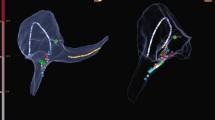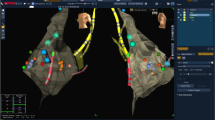Abstract
Background
Atrioventricular-nodal reentrant tachycardia (AVNRT) is a common supraventricular tachycardia, particularly in younger patients. The treatment of choice is radiofrequency catheter ablation (RFCA), traditionally necessitating ionizing radiation for catheter guidance.
Objective
The authors aimed to demonstrate the feasibility and safety of zero-fluoroscopy RFCA of AVNRT using EnSite™ NavX™ as a three-dimensional (3D) electroanatomical mapping system (EAM).
Methods
The authors retrospectively analyzed 68 patients that underwent AVNRT-RFCA. One group was a priori allocated to conventional fluoroscopy mapping (convFluoro, n = 30). In 38 cases, the electrophysiologist chose to use 3D-EAM for ablation. Of these patients, 20 could be ablated without fluoroscopy use (zeroFluoro). In 18 cases that were initially intended as 3D-EAM, additional fluoroscopy use was necessary due to difficult anatomic conditions (convertedFluoro). Procedure duration, fluoroscopy duration and dose, as well as complications were analyzed.
Results
Procedure duration was similar for the convFluoro and zeroFluoro groups (74 ± 24 min vs. 80 ± 26 min, p = ns). The convertedFluoro group showed longer procedure duration compared to the convFluoro group (94 ± 30 min vs. 74 ± 24 min, p < 0.05). The use of 3D-EAM significantly reduced fluoroscopy duration comparing the convFluoro with the convertedFluoro group (12 ± 9 min vs. 7 ± 6 min, p < 0.05). The difference in fluoroscopy dose between convFluoro and convertedFluoro did not reach significance (169 ± 166 cGycm2 vs. 134 ± 137 cGycm2, p = ns). In zeroFluoro cases, no radiation was used at all. 3D-EAM-guided RFCA was primarily successful in all patients. Overall, there were only few minor complications in the different groups. No major complications occurred.
Conclusion
Zero-fluoro RFCA in patients with AVNRT is feasible and safe. 3D-EAM can reduce radiation exposure in the majority of patients without prolonging procedure duration or increasing complications.
Zusammenfassung
Hintergrund
Die Atrioventrikularknoten-Reentrytachykardie (AVNRT) stellt besonders bei jungen Menschen eine verbreitete supraventrikuläre Tachykardie dar. Die Therapie der Wahl ist die Katheterablation in Radiofrequenztechnik (RFA), wofür klassischerweise ionisierende Strahlung zur Steuerung des Katheters eingesetzt werden muss.
Fragestellung
Ziel dieser Arbeit war es, die Durchführbarkeit und Sicherheit einer strahlenlosen AVNRT-RFA unter dem Einsatz von EnSite™ NavX™ als 3‑D-elektroanatomisches Mappingsystem (EAM) zu demonstrieren.
Methoden
Es wurden 68 Fälle einer AVNRT-RFA retrospektiv analysiert. Eine Gruppe wurde a priori dem konventionellen Mapping mit Durchleuchtung zugeteilt (convFluoro, n = 30). In 38 Fällen entschied sich der Elektrophysiologe für eine Ablation mit 3‑D-EAM. Von diesen konnten 20 Fälle ohne Durchleuchtung erfolgen (zeroFluoro). In 18 der dem 3‑D-EAM zugeordneten Fällen war die zusätzliche Nutzung von Strahlung aufgrund schwieriger anatomischer Verhältnisse notwendig (convertedFluoro). Die Auswertung umfasste Prozedurzeit, Durchleuchtungszeit und Strahlendosis sowie das Auftreten von Komplikationen.
Ergebnisse
Hinsichtlich der Prozedurzeiten fand sich kein Unterschied im Vergleich der convFluoro- und der zeroFluoro-Gruppe (74 ± 24 min vs. 80 ± 26 min, p = ns). In der convertedFluoro-Gruppe traten längere Prozedurzeiten verglichen mit der convFluoro-Gruppe auf (94 ± 30 min vs. 74 ± 24 min, p < 0,05). Durch die Nutzung des 3‑D-EAM konnte die Durchleuchtungszeit der convertedFluoro- verglichen mit der convFluoro-Gruppe signifikant reduziert werden (7 ± 6 min vs. 12 ± 9 min, p < 0,05). Hinsichtlich der Strahlendosis zeigte sich kein signifikanter Unterschied im Vergleich der convertedFluoro- mit der convFluoro-Gruppe (169 ± 166 cGycm2 vs. 134 ± 137 cGycm2, p = ns). In der zeroFluoro-Gruppe konnte vollständig auf ionisierende Strahlung verzichtet werden. Die 3‑D-EAM-gesteuerte RFA war bei allen Patienten primär erfolgreich. Insgesamt kam es zu wenigen geringfügigen Komplikationen in den verschiedenen Gruppen. Bedeutende Komplikationen traten nicht auf.
Schlussfolgerung
Die strahlungsfreie RFA in Patienten mit AVNRT ist machbar und sicher. Durch 3‑D-EAM kann die Strahlenexposition in der Mehrzahl der Patienten reduziert werden, ohne die Prozedurzeit zu verlängern oder die Komplikationsrate zu erhöhen.



Similar content being viewed by others
References
Gürsoy S, Steurer G, Brugada J, Andries E, Brugada P (1992) The hemodynamic mechanism of pounding in the neck in atrioventricular nodal reentrant tachycardia. N Eng J Med 327(11):772–774. https://doi.org/10.1056/nejm199209103271105
Brugada J, Katritsis DG, Arbelo E, Arribas F, Bax JJ, Blomstrom-Lundqvist C et al (2020) 2019 ESC guidelines for themanagement of patients with supraventricular tachycardia. Eur Heart J 41(5):655–720
Roguin A, Goldstein J, Bar O, Goldstein JA (2013) Brain and neck tumors among physicians performing Interventional procedures. Am J Cardiol 111(9):1368–1372
Marazziti D, Tomaiuolo F, Dell’Osso L, Demi V, Campana S, Piccaluga E et al (2015) Neuropsychological testing in interventional cardiology staff after long-term exposure to ionizing radiation. J Int Neuropsychol Soc 21(9):670–676
Buchanan GL, Chieffo A, Mehilli J, Mikhail GW, Mauri F, Presbitero P et al (2012) The occupational effects of interventional cardiology: results from the WIN for safety survey. EuroIntervention 8:658–663
Marinskis G, Bongiorni MG, Dagres N, Lewalter T, Pison L, Blomstrom-Lundqvist C (2013) X‑ray exposure hazards for physicians performing ablation procedures and device implantation: results of the European Heart Rhythm Association survey. Europace 15(3):444–446
Heidbuchel H, Wittkampf FHM, Vano E, Ernst S, Schilling R, Picano E et al (2014) Practical ways to reduce radiation dose for patients and staff during device implantations and electrophysiological procedures. Europace 16(7):946–964
Klein LW, Tra Y, Garratt KN, Powell W, Lopez-Cruz G, Chambers C et al (2015) Occupational health hazards of interventional cardiologists in the current decade: results of the 2014 SCAI membership survey. Cathet Cardiovasc Interv 86(5):913–924
Pentinga ML, Meeder JG, Crijns HJGM, de Muinck ED, Wiesfeld ACP, Lie KI (1993) Late onset atrioventricular nodal tachycardia. Int J Cardiol 38(3):293–298
Limacher MC, Hair C, Douglas PS, Germano G, Laskey WK, Lindsay BD et al (1998) ACC expert consensus document radiation safety in the practice of cardiology. Cardiology 31(4):892–913
Hill KD, Einstein AJ (2016) New approaches to reduce radiation exposure. Trends Cardiovasc Med 26(1):55
Schmitt C, Ndrepepa G, Deisenhofer I, Schneider M (1999) Recent advances in cardiac mapping techniques. Curr Cardiol Rep 1(2):149–156. https://doi.org/10.1007/s11886-999-0074-0
Maury P, Monteil B, Marty L, Duparc A, Mondoly P, Rollin A (2018) Three-dimensional mapping in the electrophysiological laboratory. Arch Cardiovasc Dis 111(6–7):456–464
Casella M, Dello Russo A, Pelargonio G, Del Greco M, Zingarini G, Piacenti M et al (2016) Near zerO fluoroscopic exPosure during catheter ablAtion of supRavenTricular arrhYthmias: the NO-PARTY multicentre randomized trial. Europace 18:1565–1572
Ebrille E, Caponi D, Siboldi A, Di Donna P, Di Clemente F, Gabbarini F et al (2013) Single center experience of fluoroless AVNRT ablation guided by electroanatomic reconstruction in children and adolescents. Eur Heart J 34(suppl_1):P4974–P4974
Debreceni D, Janosi K, Vamos M, Komocsi A, Simor T, Kupo P (2022) Zero and minimal fluoroscopic approaches during ablation of supraventricular tachycardias: a systematic review and meta-analysis. Front Cardiovasc Med 9:856145
Fernández-Gómez JM, Moriña-Vázquez P, Morales EDR, Venegas-Gamero J, Barba-Pichardo R, Carranza MH (2014) Exclusion of fluoroscopy use in catheter ablation procedures: six years of experience at a single center. J Cardiovasc Electrophysiol 25(6):638–644. https://doi.org/10.1111/jce.12385
Swissa M, Birk E, Dagan T, Naimer SA, Fogelman M, Einbinder T et al (2017) Radiofrequency catheter ablation of atrioventricular node reentrant tachycardia in children with limited fluoroscopy. Int J Cardiol 236:198–202
Giaccardi M, Del Rosso A, Guarnaccia V, Ballo P, Mascia G, Chiodi L et al (2016) Near-zero x‑ray in arrhythmia ablation using a 3-dimensional electroanatomic mapping system: a multicenter experience. Heart Rhythm 13(1):150–156
Gerguri S, Jathanna N, Lin T, Müller P, Clasen L, Schmidt J et al (2018) Clinical impact of “pure” empirical catheter ablation of slow-pathway in patients with non-ECG documented clinical on-off tachycardia. Eur J Med Res 23(1):1–7. https://doi.org/10.1186/s40001-018-0314-0
Schmitt C, Deisenhofer I, Zrenner B (2006) Catheter ablation of cardiac arrhythmias. Steinkopff, Darmstadt
Kopelman HA, Prater SP, Tondato F, Chronos NAF, Peters NS (2003) Slow pathway catheter ablation of atrioventricular nodal re-entrant tachycardia guided by electroanatomical mapping: a randomized comparison to the conventional approach. Europace 5(2):171–174
Ebrille E, Caponi D, Siboldi A, Di Donna P, Di Clemente F, Gabbarini F et al (2013) Single center experience of fluoroless AVNRT ablation guided by electroanatomic reconstruction in children and adolescents. Eur Heart J 34(suppl_1):P4974–P4974
Chen G, Wang Y, Proietti R, Wang X, Ouyang F, Ma CS et al (2020) Zero-fluoroscopy approach for ablation of supraventricular tachycardia using the Ensite NavX system: a multicenter experience. BMC Cardiovasc Disord 20(1)
Lehar F, Szegedi N, Hejc J, Jez J, Soucek F, Kulik T et al (2022) Randomized comparison of atrioventricular node re-entry tachycardia and atrial flutter catheter ablation with and without fluoroscopic guidance: ZeroFluoro study. Europace 24(10):1636–1644
Kanitsoraphan C, Techorueangwiwat C, Rattanawong P, Kewcharoen J, Ayinapudi K, Bunch TJ et al (2021) Zero fluoroscopy approach versus fluoroscopy approach for cardiac arrhythmia ablations: a systematic review and meta-analysis. J Cardiovasc Electrophysiol 32(10):2761–2776. https://doi.org/10.1111/jce.15221
Yang L, Sun G, Chen X, Chen G, Yang S, Guo P et al (2016) Meta-analysis of zero or near-zero fluoroscopy use during ablation of cardiac arrhythmias. Am J Cardiol 118(10):1511–1518
Earley MJ, Showkathali R, Alzetani M, Kistler PM, Gupta D, Abrams DJ et al Radiofrequency ablation of arrhythmias guided by non-fluoroscopic catheter location: a prospective randomized trial.
Bergonti M, Dello Russo A, Sicuso R, Ribatti V, Compagnucci P, Catto V et al (2021) Long-term outcomes of near-zero radiation ablation of paroxysmal supraventricular tachycardia: a comparison with fluoroscopy-guided approach. JACC Clin Electrophysiol 7(9):1108–1117. https://doi.org/10.1016/j.jacep.2021.02.017
Efstathopoulos EP, Katritsis DG, Kottou S, Kalivas N, Tzanalaridou E, Giazitzoglou E et al (2006) Patient and staff radiation dosimetry during cardiac electrophysiology studies and catheter ablation procedures: a comprehensive analysis. Europace 8(6):443–448
Lickfett L, Mahesh M, Vasamreddy C, Bradley D, Jayam V, Eldadah Z et al (2004) Radiation exposure during catheter ablation of atrial fibrillation. Circulation 110(19):3003–3010. https://doi.org/10.1161/01.CIR.0000146952.49223.11
Perisinakis K, Damilakis J, Theocharopoulos N, Manios E, Vardas P, Gourtsoyiannis N (2001) Accurate assessment of patient effective radiation dose and associated detriment risk from radiofrequency catheter ablation procedures. Circulation 104(1):58–62. https://doi.org/10.1161/hc2601.091710
Gerber TC, Carr JJ, Arai AE, Dixon RL, Ferrari VA, Gomes AS et al (2009) Ionizing radiation in cardiac imaging. Circulation 119(7):1056–1065. https://doi.org/10.1161/CIRCULATIONAHA.108.191650
Mah DY, Miyake CY, Sherwin ED, Walsh A, Anderson MJ, Western K et al (2014) The use of an integrated electroanatomic mapping system and intracardiac echocardiography to reduce radiation exposure in children and young adults undergoing ablation of supraventricular tachycardia. Europace 16(2):277–283
Lahiri A, Srinath SC, Chase D, Roshan J (2017) Zero fluoroscopy radiofrequency ablation for typical atrioventricular nodal reentrant tachycardia (AVNRT). Indian Pacing Electrophysiol J 17(6):180–182
Andreassi MG, Ait-Ali L, Botto N, Manfredi S, Mottola G, Picano E (2006) Cardiac catheterization and long-term chromosomal damage in children with congenital heart disease. Eur Heart J 27(22):2703–2708
Beels L, Bacher K, De Wolf D, Werbrouck J, Thierens H (2009) γ‑H2AX foci as a biomarker for patient X‑Ray exposure in pediatric cardiac catheterization. Circulation 120(19):1903–1909. https://doi.org/10.1161/CIRCULATIONAHA.109.880385
Kochar A, Ahmed T, Donnellan E, Wazni O, Tchou P, Chung R (2021) Operator learning curve and clinical outcomes of zero fluoroscopy catheter ablation of atrial fibrillation, supraventricular tachycardia, and ventricular arrhythmias. J Interv Card Electrophysiol 61(1):165–170. https://doi.org/10.1007/s10840-020-00798-8
Author information
Authors and Affiliations
Corresponding author
Ethics declarations
Conflict of interest
C. Soether, A.A. Boehmer, B.C. Dobre, B.M. Kaess and J.R. Ehrlich declare that they have no competing interests.
For this article no studies with human participants or animals were performed by any of the authors. All studies mentioned were in accordance with the ethical standards indicated in each case.
Additional information
Publisher’s Note
Springer Nature remains neutral with regard to jurisdictional claims in published maps and institutional affiliations.

Scan QR code & read article online
Rights and permissions
About this article
Cite this article
Soether, C., Boehmer, A.A., Dobre, B.C. et al. Zero-fluoro atrioventricular-nodal reentrant tachycardia ablation. Herzschr Elektrophys 34, 305–310 (2023). https://doi.org/10.1007/s00399-023-00977-w
Received:
Accepted:
Published:
Issue Date:
DOI: https://doi.org/10.1007/s00399-023-00977-w
Keywords
- X-ray reduction
- Conventional ablation
- Electrophysiology
- Supraventricular tachycardia
- Radiofrequency ablation




